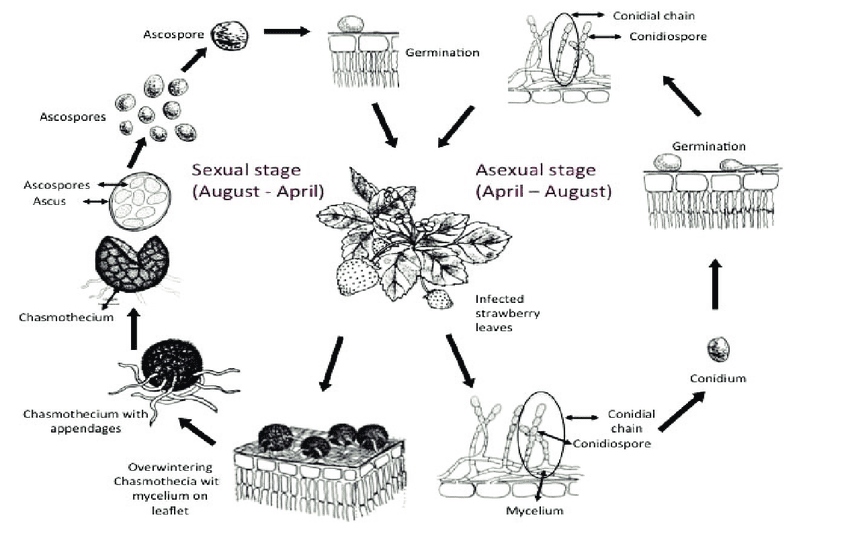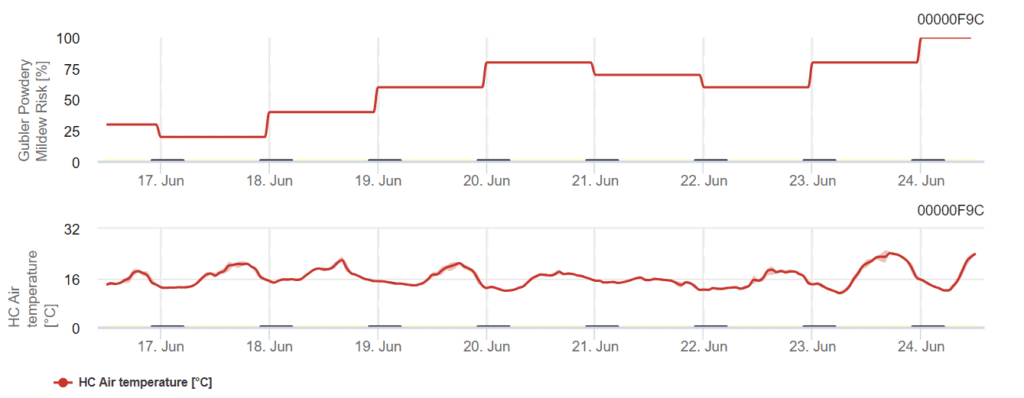
Eper betegségmodellek
Anthracnose
Kórokozó
A szamóca antraknózisa, amelyet a következők okoznak Colletotrichum acutatum, a száron, a hajtásokon és a terméseken fekete, beesett sérülések formájában jelentkezik. Ez a gombabetegség a növény minden részét érinti, beleértve a koronát, a gyökereket, a levélnyelet és a hajtásokat.
A betegség kedvező körülmények között gyorsan kifejlődhet, a gyümölcsök 90%-je egy héten belül vagy annál rövidebb idő alatt fertőződhet meg. Az éretlen és az érett gyümölcsök egyaránt fogékonyak a fertőzésre, de a betegség leginkább az érő vagy teljesen érett gyümölcsökön fordul elő. A fertőzött növények vagy növényi törmelékek a telelő inokulum forrásául szolgálhatnak. Tavasszal a spórákat az eső és a szél termeli és szórja szét viszonylag rövid távolságra.
A kórokozó egy appresszoriumon keresztül jut be a növénybe, amely áthatol a kutikulán és behatol az epidermális sejtekbe. Kezdetben, C. acutatum biotróf fázisban létezik, majd átvált nekrotróf fázisba, amelyben a gomba az elhalt sejteken belül szaporodik. A betegség előrehaladtával a gomba az epidermális sejtfalak alatt akervuláris struktúrákat képez. Ezek az acervulusok megérnek és konídiumokat bocsátanak ki, amelyek gyorsabban terjesztik a betegséget, különösen esőzés hatására. A másodlagos konídiumok jelentős inokulumforrásként is szolgálnak.
Tünetek
A tünetek először a legfiatalabb levelek hervadásában jelentkeznek, amelyek átmenetileg helyreállhatnak, de hamarosan elhalnak. A leveleken, különösen a levélkék csúcsán szabálytalan fekete foltok jelennek meg.
A koronaszövet ekkor vöröses elszíneződést mutat, amely végül sötétbarnává vagy feketévé válik, ahogy a növény pusztul. A fertőzött koronák gyakran részlegesen károsodnak, ami a növény növekedésének elmaradásához, de nem teljes pusztulásához vezet. Jellemzően a koronának csak az egyik oldala fertőződik, nem pedig az egész korona.
A levélnyélen és a futószáron sötét, hosszúkás elváltozások alakulnak ki. A károsodott levélnyelek és szárak a sérülések által körülvehetők, ami a levelek vagy a teljes leánynövények hervadásához és elhalásához vezethet.
A gyümölcsök a fejlődés bármely szakaszában megfertőződhetnek, megkeményednek és barnára színeződnek. Az érett gyümölcsökön süllyedt, sötét sérülések alakulnak ki, amelyek érés helyett mumifikálódáshoz vezetnek. A gyümölcsöket rózsaszín vagy lazacszínű konídiumtömegek is boríthatják.
FieldClimate modell
Általános antraknózis modell
Szükséges érzékelők:
- Levegő hőmérséklete
- Levélnedvesség
C. acutatum 15°C és 30°C közötti hőmérséklet-tartományban fertőzi a növényeket, de hosszan tartó levélnedvesedési periódusra van szükség. A 20°C és 25°C közötti optimális hőmérsékleten 12 órás levélnedvesítési időszak szükséges. Amikor a fertőzési grafikon eléri az 100% értéket, a szántóföldön optimális feltételek adottak a fertőzéshez.
Irodalom
- Aljawasim, B. D., Samtani, J. B., & Rahman, M. (2023). Új felismerések a szamóca antraknózisos betegségeinek felismerésében és kezelésében. Plants, 12(21), 3704.
- Ellis, M. A., & Erincik, O. (2008). A szamóca antraknózisa. The Ohio State University Extension.
- Smith, B. J. (2008). A szamóca antraknózis epidemiológiája és patológiája: észak-amerikai perspektíva. HortScience, 43(1), 69-73.
Lisztharmat
Kórokozó

A szamóca lisztharmatának kórokozója a következő Podosphaera aphanis. Két formában telel át - micéliumban és kleisztotéciumban.
A telelő micélium tavasszal aktívvá válik, és konídiumokat termel, amelyek érett állapotban konídiumokat (ivartalan szaporító spórákat) bocsátanak ki. A konídiumok új szöveten landolnak, kicsíráznak, és appressóriumokat, speciális fertőzési struktúrákat képeznek, amelyek behatolnak a növényi sejtekbe. A folyamat új kolónia kialakulását eredményezi.
A kleisztotéciumok márciustól májusig bocsátanak ki aszkospórákat (ivaros szaporító spórákat). Az aszkospórák új szöveteken is landolnak, kicsíráznak és új kolóniákat alkotnak.
Mind a micélium, mind a konídiumok elsődleges inokulumként szolgálnak. A másodlagos fertőzések többnyire konídiumokon keresztül történnek, amelyeket a szél terjeszt és gyorsan terjednek.
Amikor a környezeti feltételek kedvezőtlenebbé válnak, a gomba áttér az ivaros szaporodásra - a kleisztotéciumképződésre -, és a ciklus megismétlődik, ahogy az inokulumok telelnek.
Tünetek
A micéliumok és konídiumok fehér, porszerű foltjai minden légnemű részen megjelennek, és az egész felületet beborítva összeolvadnak. A fiatal szervek fogékonyabbak, mint az idősebbek. A levelek esetében a felső oldalon nagyobb a lisztharmat, mint az alsó oldalon. A súlyos fertőzés csökkent fotoszintézist, lombhullást és a termés deformálódását okozza. A betegség előrehaladtával a levél felfelé görbül, és a levél felületén lilás vagy vöröses foltok alakulnak ki.
FieldClimate modellek
Broome módosított Gubler-modell
Szükséges érzékelők:
- Levegő hőmérséklete
A modell a Gubler-féle keretrendszeren alapul, a Broome által bevezetett magas hőmérsékleti küszöbértékek módosításával. A kockázatot a léghőmérséklettel együtt számítja ki, és a kockázati index 0 és 100 között mozog. Az index aktiválásához három olyan egymást követő napra van szükség, amikor a hőmérséklet több mint 6 órán keresztül 21°C és 30°C között van.
Az index 20 ponttal nő minden olyan nap után, amely megfelel ezeknek a feltételeknek (legalább 6 óra 21°C és 30°C közötti hőmérséklet). Ezzel szemben, ha egy nap kevesebb mint 6 órát tölt el ebben a hőmérsékleti tartományban, vagy ha a hőmérséklet meghaladja a 35°C-ot, az index 10 ponttal csökken.

Az eredeti Gubler-modell 0,35 órára 35°C-os küszöbértéket állapított meg, de Broome több részletes magas hőmérsékleti küszöbértéket is bevezetett. Ha bizonyos hőmérsékleti értékek (34°C, 36°C és 38°C) megfelelő időtartamban teljesülnek, a pontok levonásra kerülnek. A modell emellett figyelembe veszi a gombák növekedésének késleltetését; a következő napon bekövetkező indexnövekedés több napot késik, és minden késleltetett nap után öt extra pontot vonnak le.
A 30 alatti index 15 napos vagy annál rövidebb szaporodási időt jelez, míg a 40-50-es index normálisnak tekinthető, ami 8-11 napos szaporodási időt jelent. A 60 feletti index azt jelzi, hogy a kórokozó 5 naponként szaporodik, és a permetezési időköz lerövidítése javasolt.
Eper lisztharmat modell
Szükséges érzékelők:
- Levegő hőmérséklete
- Relatív páratartalom
- Levélnedvesség
Ez a modell a levélnedvességet és a relatív páratartalmat egy másik modellbe foglalja. A 21 °C feletti levegő hőmérséklete és a 66% feletti relatív páratartalom növeli a kockázatot, míg az alacsonyabb hőmérséklet, relatív páratartalom és levélnedvesség csökkenti a kockázatot.
A 60 alatti kockázati index alacsony szintű növényvédelmi intézkedéseket jelez, míg a 60 feletti kockázat megnövekedett betegségkockázatot jelez, és permetezés javasolt. A 100-as betegségkockázat hosszabb időn keresztül a kijuttatási sűrűség növelését teszi szükségessé.
Irodalom
- Broome, J. C., Hand, E. K., Backup, P., Janousek, C. N., & Gubler, W. D. (2010, június). A Gubler-Thomas szőlő lisztharmat kockázati index magas hőmérsékleti küszöbértékének felülvizsgálata. In PHYTOPATHOLOGY (Vol. 100, No. 6, pp. S17-S18). 3340 PILOT KNOB ROAD, ST PAUL, MN 55121 USA: AMER PHYTOPATHOLOGICAL SOC.
- Gadoury, D. M., Asalf, B., Heidenreich, M. C., Herrero, M. L., Welser, M. J., Seem, R. C., ... & Stensvand, A. (2010). A Podosphaera aphanis cleistotheciáinak kezdeményezése, fejlődése és túlélése, valamint szerepük az eper lisztharmat epidemiológiájában. Phytopathology, 100(3), 246-251.
- Jin XiaoLei, J. X., Fitt, B. D. L., Hall, A. M., & Huang YongJu, H. Y. (2013). A chasmotheciák szerepe a lisztharmat (Podospheara aphanis) járványok megindulásában és a szilícium szerepe a járványok megfékezésében a szamócán.
- Palmer, S. A. (2007). Eper lisztharmat: járványtan és a gazdatáplálkozás hatása a betegségre (doktori disszertáció).
- Aldrighetti, A., & Pertot, I. (2023). A szamóca lisztharmat epidemiológiája és védekezése: áttekintés. Phytopathologia Mediterranea, 62(3), 427-453.
Ajánlott felszerelés
Ellenőrizze, hogy melyik érzékelőkészletre van szükség a növény potenciális betegségeinek megfigyeléséhez.
